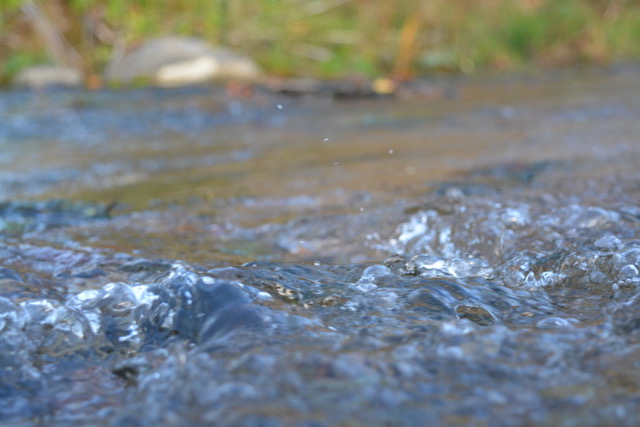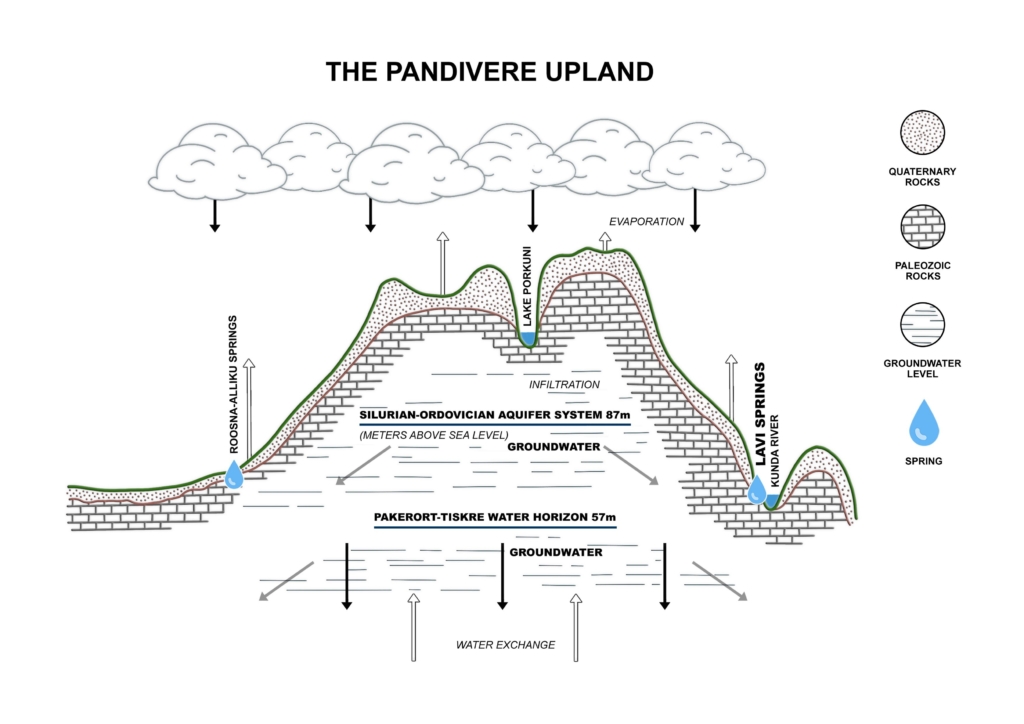Why is natural spring water better than processed water from a bored well?

Industrially processed drinking water and that of the water supply system do not entirely comply with the needs of the body since the water is cleaned via several procedures and often enriched with synthetic minerals. The human body is adjusted to drinking fresh living water that is purified by nature itself and has retained its organic structure. Processed water protects the tubing of the water system, household gadgets and against bacterial contamination, but does not support the microbiota nor provide essential natural minerals. Long-term consumption of industrial water may enhance diseases and chronic infections because processed water is not inherent to the body.
Spring water differs from the water of deeper layers by its chemical content. In the near-surface layers of groundwater with aerobic conditions and fast water exchange, the content of microelements is moderate. There are no such harmful or excessive elements that may be present in deeper layers (barium, ferrous iron, hydrogen sulfide, radionuclides, ammonium ions, methane, boron, excessive fluoride, and dissolved solids); in the upper layers, the content of fluoride is optimal. Regular overconsumption of highly-mineralised water can cause different health issues due to high salinity and certain microelements accumulating in the body.
In order to use the deeper layers of groundwater as a source of drinking water, the water is treated with methods such as aeration, filtration, and chemical processing. In certain cases, the aeration is followed by applying strong chemical oxidizing agents such as ozone (O3), chlorine (Cl2), or potassium permanganate (KMnO4) to ensure the final oxidation. In case of spring water, none of it is necessary.
Where does Lavi spring water come from?
The springs of Lavi village are located in Vinni Municipality, Lääne-Viru County, in the eastern part of the Pandivere Upland. Lavi springs border on the kames of Männikvälja with rheocrenes opening on the sides. Depending on the season and the amount of precipitation, the total discharge of the Lavi springs is 108–441 L/s. The resurgence of our spring is 20 to 30 litres per second. The relatively uniform temperature remains around 6 °C throughout the year.

The Pandivere Upland in the Northern Estonia spreads over 1,100 square kilometres and is located 80–130 metres above sea level. The area differs from the rest of Estonia for its terrain features and climate. The Pandivere Upland is a preglacial erosional upland that is clearly distinguishable from the hilly accumulative uplands of Estonia, formed during the Ice Age.
Autumn arrives earlier and spring later, and winter is longer than elsewhere in Estonia. Therefore, both the amount of precipitation and groundwater recharge from snowfall are bigger. There are no permanent rivers and creeks in the central part of Pandivere Upland: the water is absorbed into the ground where it is cleaned and mineralised when reaching the aquifer laying in the subsurface. The central part of the upland is surrounded by a circle of Estonia’s largest springs. Groundwater forces itself into the springs, many of which form the sources of our most significant rivers. Beneath the surface, there are several karst aquifers – groundwater reservoirs that feed the springs.
Water is filtered through the glacial moraine cover and the sedimentary rock formed in a shallow marine environment 0.5 billion years ago. The limestone bedrock which is situated 50–60 m higher than the surrounding lowlands consists of Ordovician and Silurian carbonate skeletons, that is, biogenic limestone. Biogenic limestone, together with the fossils, contains all the essential minerals.
One of the springs in Pandivere Upland are the Lavi springs, famous since ancient times as a source of good clean drinking water.
Lavi springs are located above vertical tectonic fractures, through which spring water rises to the surface in the Pakerort Stage and Tiskre Formation, two rock layers mainly consisting of sandstone and aleurolite. There, the rising water mixes with the upper part of the water horizon. The water of those systems, now intermixed and forced to the surface, has the best features of both groundwater and surface water: it is not as vulnerable to human activity as surface water, yet it contains no harmful substances like the deeper layers of groundwater.
Lavi spring water is a good source of minerals! Filtered by free-flowing through limestone and sandstone, Lavi spring water contains a considerable amount of calcium carbonate (also known as lime) and other natural minerals crucial for the human body. Calcium is especially beneficial for the 50+ age group in avoiding bone density loss.
Natural spring water that contains calcium bicarbonate may not help with the appearance of the coffee machine because of the build-up of limescale, but it protects your health. Ask yourself, which is more important?
Protection of Pandivere water supply and vision for sustainable development
The Pandivere Upland forms a unique area, which supplies a substantial part of Estonia with clean water. The Pandivere Upland has been referred to as the water tower of Estonia. The ‘tap’ of Lavi spring water is straight at the foot of this water tower.
The singular features of the Pandivere Upland have been emphasised for decades. In 1995, the Sustainable Development Act established the principles of sustainability in Pandivere and Ida-Viru County, regarding the use of natural resources in economic activity. In order to protect Pandivere’s groundwater system, the Pandivere Groundwater Sub-River Basin District (2001) and the Pandivere Nitrate Vulnerable Zone (2003) have been established.
According to the principles of sustainable development, the Pandivere Upland is a biologically diverse district where agricultural areas coexist with wilderness areas, comprising karst channels and springs, protected forests, and extensive farming areas (permanent grasslands, organic farmlands). Pandivere Upland provides Estonia with top-quality drinking water, stands out for conserving important aquatic habitats and landscapes, and offers the opportunity for recreational fishing.
History and present-day
One of the Lavi springs is the famous Lavi sacrificial spring. The significance of this ancient holy spring is marked by a nearby sacrificial stone and a holy pine tree. The sacrificial spring is and always has been abound in water. In the past, the sound of it could be heard at a very long distance – during high water and in quiet weather even in Uuemõisa village 2.5 kilometres away.
The stream flowing out from the Lavi sacrificial spring supplied three watermills in the surrounding manor’s lands. On the banks of the spring stood the hunting cabin of the landlord himself, facing the large sacrificial stone of the villagers.
Why does Lavi spring water come in a pouch and not in a bottle?
For Lavi spring water to preserve its distinctive fresh taste, the water is packaged in 5-litre BPA-free vacuum pouches, which are light-tight and suitable for storing water. The water is released via the butterfly tap that prevents air from entering the package. If the pouch is kept in cool conditions, the water tastes like straight from the spring!
The energy demand of packaging and transport of water pouches is significantly lower than that of water bottles, making them more environmentally sustainable in that regard. The bag can be reused at home. The material is fully recyclable.
Water quality
We complement nature with modern technology and knowledge of hygiene, microbiology, hydrogeology, engineering, chemistry, and physiology. Our newly renovated production facility is compliant with the regulations by Veterinary and Food Board. The water has been thoroughly tested in the leading laboratories of Estonia and Finland and is being constantly monitored.
For cooking, drinking and staying healthy!
With best wishes,
the family of Lavi Vesi
